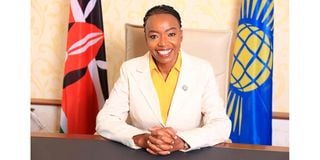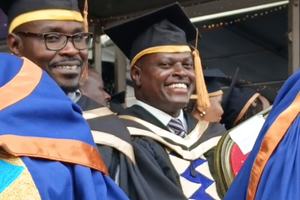Premium
How EA women ate the men’s lunch

Defence Cabinet Secretary Monica Juma.
What you need to know:
- What makes the Kenyan case notable, is both the Foreign and Defence dockets have been held by women since the Jubilee government came to office in 2013.
- It mirrors an equally interesting picture in Uganda, where both the Prime Minister and Vice President are women; Robinah Nabbanja and Jessica Alupo, respectively.
President Uhuru Kenyatta has nominated Defence Cabinet Secretary Monica Juma for the post of secretary-general of the Commonwealth.
The appointment of the organisation’s next secretary-general will be made at the upcoming Commonwealth Heads of Government Meeting (CHOGM), so Ms Juma will know then whether she’s bested other candidates.
CHOGM, which was to take place in the Rwandan capital Kigali, has now been postponed twice; in 2020 and this year due to the Covid-19 pandemic. The Juma announcement elicited some excitement, but equally interesting as where Juma might be going is where she is coming from.
Previous to her appointment to Defence in 2018, she was CS for Foreign Affairs. Her predecessor as Defence minister was Raychelle Omamo, she had been in the job since May 2013 following the coming to office of President Uhuru Kenyatta. Omamo is, of course, now CS for Foreign Affairs. Juma took over Foreign Affairs from Amina Mohamed.
In most of Africa, since the mid-50s to mid-60s independence, Defence and Foreign were meaty jobs the boys and strongmen.
In Africa, East Africa has been the region that collectively started to open up these hefty ministerial dockets to women the most. In Rwanda, Louise Mushikiwabo put in one of the longest stretches of a Foreign Minister in the region, from 2009 to 2018.
It ended in tears
When Tanzania’s Foreign Minister Liberata Mulamula was appointed to the job in March, she became the second woman to be the face of Tanzania internationally. Asha-Rose Migiro had been there until she left to eat a chieftainship at the United Nations in New York.
In Uganda, Princess Elizabeth Bagaya, in her prime alleged to have been one of the most beautiful women to walk the face of Africa, was the ground-breaker, appointed Foreign Minister by dictator Idi Amin in 1974. She didn’t last long. It ended in tears.
Even South Sudan, which is no country for women, has Beatrice Wani-Noah as Foreign Minister. What makes the Kenyan case notable, is both the Foreign and Defence dockets have been held by women since the Jubilee government came to office in 2013. Usually, the patriarchs will keep one of these jobs for themselves.
It mirrors an equally interesting picture in Uganda, where both the Prime Minister and Vice President are women; Robinah Nabbanja and Jessica Alupo, respectively.
Something is going on, and the guardians of male power are probably smelling it but not seeing it – the girls, so to speak, are running away with it.
Some critics argue that it is all cynical politics. In Uganda’s case, that neither Nabbanja nor Alupo are likely to challenge President Yoweri Museveni’s succession plans. That, because Ugandan women tend to be more centrist and less violent in their politics, none of them will go to the city square in Kampala with machetes and clubs to fight Museveni for the throne. There is something sexist about that argument, but we shall dwell on it another time.
However, the democratic movements of the last 30 years have seen women score political victories, with constitutions that had special seats for them in Parliament, and quotas in some national and local government offices.
Financially independent
For some of those reasons, for example, women comprise 62 per cent of the Rwandan legislature, the highest in the world. Scratch beneath the surface, though, and a more complex picture emerges.
The idea that the rise of more and more women to the top of powerful political positions in Africa is a result of affirmative action and an exhausted patriarchy ceding ground tactically, ignores far-reaching social changes and hardnosed political organising and strategising women leaders and activists have invested in.
An insightful article in National Geographic, for example, credits Rwanda’s cross-party women’s caucus, the Rwanda Women Parliamentary Forum, for quite a few of the political gains. The Forum, it reports, “developed a strategy to expand the number of seats occupied by women beyond the 30 per cent required by the constitution. They had veteran lawmakers run for open seats and ushered in newcomers to the reserved seats, compounding gains”.
A cross-party organisation came up with a plan not to run against each, and to push the female politicians with a high public profile and track record to fight it out with the boys and channelled the newcomers to the reserved seats. Can you imagine the men even sitting down to discuss such a plan?
There are more women than men in nearly all the East African countries. That of itself isn’t decisive. Where it matters is that we are seeing a trend where more women who registered to vote turn out to cast the ballot than men. Of course, the female vote is not yet universally progressive, and in the rural areas in Africa can be quite conservative, but increasingly more and more of it is going to women candidates.
And as the number of socially and financially independent women, which is growing at record rates, continues to rise, the fiery muscle men of African politics are getting fewer of their votes. The women’s train has left the station.
Mr Onyango-Obbo is a journalist, writer, and curator of the “Wall of Great Africans”. Twitter@cobbo3





